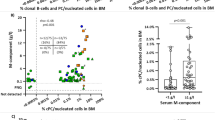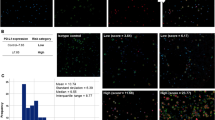Abstract
The study focused on determining the expression of substance P (SP) in neoplastic bone marrow cells in childhood acute lymphoblastic leukaemia (ALL) in terms of its mRNA and the level of protein production. An attempt has also been made to demonstrate a correlation of SP with leukaemia risk factors and treatment failure. The study group comprised 120 children treated for ALL. Expression of SP was examined by in situ hybridisation with a 5′-biotinylated probe and by immunocytochemistry with specific anti-human SP antibody. Out of 80 patients with common ALL, the expression of SP was demonstrated in 33 cases (41.2%). In the group of 24 children with pre-B ALL, the presence of SP was noted in six cases (25.0%). Of 16 patients with T-cell leukaemia, SP expression was demonstrated in 13 cases (81.2%). The percentage of immunopositive cells in the SP-positive cases ranged from 79.8 to 97.3. Treatment failure in the children with ALL was closely related to the expression of SP observed at the beginning of treatment. The results showed a connection between the presence of SP-positive blasts and leukaemia relapse. This may indicate that SP expression, involved in the proliferation of the tumour cells, may represent a novel risk factor in ALL.
This is a preview of subscription content, access via your institution
Access options
Subscribe to this journal
Receive 12 print issues and online access
$259.00 per year
only $21.58 per issue
Buy this article
- Purchase on Springer Link
- Instant access to full article PDF
Prices may be subject to local taxes which are calculated during checkout
Similar content being viewed by others
References
Maggio J . Tachykinins. Ann Rev Neurosci 1990; 11: 13–26.
Rameshwar P, Gascon P . Haematopoietic modulation by the tachykinins. Acta Hematol 1997; 98: 59–64.
Rameshwar P, Gascon P . Substance P (SP) mediates production of stem cell factor and interleukin-1 in bone marrow stroma: potential autoregulatory role for these cytokines in SP receptor expression and induction. Blood 1995; 86: 482–490.
Felten D, Felten S, Carlson S . Noradrenergic and peptidergic innervation of lymphoid tissue. J Immunol 1985; 135(Suppl. 2): 7559–7655.
Savino W, Dardenne M . Immuno-neuroendocrine interactions. Immunol Today 1995; 16: 318–329.
Sirinek L, O'Dorisio M . Modulation of immune function by intestinal neuropeptides. Acta Oncologica 1991; 30: 509–518.
Mastrangelo R, Poplack D, Bleyer A, Riccardi R, Sather A, D'Angio G . Report and recommendations of the Rome Workshop concerning poor-prognosis acute lymphoblastic leukaemia in children: biologic bases for staging, stratifications and treatment. Med Pediatr Oncol 1986; 14: 191–194.
Raimondi SC . Current status of cytogenetic research in childhood acute lymphoblastic leukalemia. Blood 1993; 81: 2237–2251.
Schultz KR, Massing B, Spinelli JJ . Importance of the day 7 bone marrow biopsy as a prognostic measure of the outcome in children with acute lymphoblastic leukaemia. Med Pediatr Oncol 1997; 29: 16–22.
Volm M, Zintl F, Edler L, Sauerbrey A . Prognostic value of protein kinase C, proto-oncogene products and resistance-related proteins in newly diagnosed childhood lymphoblastic leukaemia. Med Pediatr Oncol 1997; 28: 117–126.
Steinherz PG, Gaynon PS, Miller DR, Reaman G, Bleyer A, Finklestein J et al. Improved disease-free survival of children with acute lymphoblastic leukaemia at high risk for early relapse with New York regimen – a new intensive therapy protocol: a report from Children's Cancer Study Group. J Clin Oncol 1986; 4: 744–752.
Reihm H . Multizentrische Therapiestudie ALL-BFM-90 zur Behandlung von Kindern und Jugendlichen mit Akuter Lymphoblastischer Leukämie (Non-B-ALL). Hannover: Therapieprotokoll, 1991.
Nowicki M, Miskowiak B, Kaczmarek-Kanold M, Partyka M . Prognoza ewolucji hipoplazji szpiku kostnego w oparciu o immunocytochemiczne wystpowanie substancji P. Prz Ped 2001; 31: 273–277.
Hsu S, Raine L, Fanger H . Use of avidin–biotin peroxidase complex (ABC) in immunoperoxidase techniques: a comparison between ABC and unlabeled antibody (PAP) procedures. J Histochem Cytochem 1981; 29: 577–580.
Shi SR, Cote RJ, Taylor CR . Antigen retrieval immunocytochemistry: past, present and future. J Histochem Cytochem 1997; 45: 327–343.
Crist WM, Grosse CE, Pullen J . Immunologic markers in childhood acute lymphoblastic leukaemia. Semin Oncol 1985; 12: 105–112.
Coghlan J, Aldred P, Haralambidis J, Niall H, Penschow J, Tregear G . Hybridisation histochemistry. Anal Biochem, 1985; 149: 1–28.
Elias J, Gown A, Nakamura R . Special report: quality control in immunohistochemistry. Am J Clin Pathol 1989; 92: 836–843.
Nowicki M, Miskowiak B, Konwerska A . Expression of CD79a antigen in acute lymphoblastic leukaemia in children. Folia Histochem Cytobiol 1999; 37: 149–150.
Rameshwar P, Ganea D, Gascon P . In vitro effect of substance P on hematopoiesis. Blood 1993; 81: 391–399.
Lambrecht B, Germonpre P, Evereart E, Carro-Muino I, DeVeerman M, de Filipe C et al. Endogenously produced substance P contributes to lymphocyte proliferation induced by dendritic cells and direct Tcr ligation. Eur J Immunol 1999; 29: 3815–3825.
Rameshwar P, Poddar A, Gascon P . Haematopoietic regulation mediated by interactions among the neurokinins and cytokines. Leukemia Lymphoma 1997; 28: 1–10.
Watt S, Chan J . CD164 – a novel sialomucin on CD 34+ cells. Leukemia Lymphoma 2000; 37: 1–25.
Acknowledgements
We thank Professor Geoffrey Shaw for his assistance with the English text.
Author information
Authors and Affiliations
Rights and permissions
About this article
Cite this article
Nowicki, M., Miśkowiak, B. Substance P – a potent risk factor in childhood lymphoblastic leukaemia. Leukemia 17, 1096–1099 (2003). https://doi.org/10.1038/sj.leu.2402920
Received:
Accepted:
Published:
Issue Date:
DOI: https://doi.org/10.1038/sj.leu.2402920
Keywords
This article is cited by
-
Association of genetic variants in tachykinins pathway genes with colorectal cancer risk
International Journal of Colorectal Disease (2012)
-
The NK-1 receptor is expressed in human leukemia and is involved in the antitumor action of aprepitant and other NK-1 receptor antagonists on acute lymphoblastic leukemia cell lines
Investigational New Drugs (2012)



